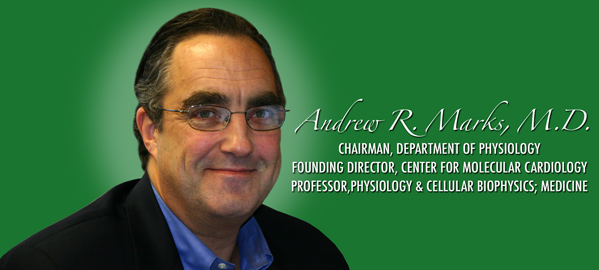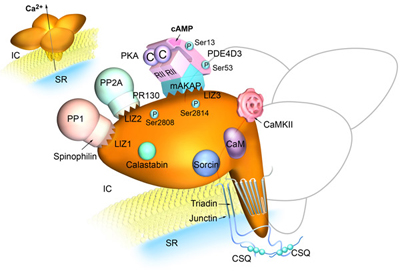
CURRENT RESEARCH
Molecular mechanisms of muscle function, human diseases of muscle, vascular smooth muscle and lymphocyte activation
A major focus of the laboratory is the study of mechanisms that regulate muscle contraction. In particular we use a variety of techniques including molecular biology, biophysics, cell biology, imaging (Live5 Zeiss Confocal), and structural biology to gain better understandings of the regulation of calcium release channels on the  sarcoplasmic reticulum that control excitation-contraction (EC) coupling in cardiac and skeletal muscle. There are opportunities for graduate students and postdoctoral fellows to head their own projects using any of the various techniques that we employ to examine the regulation of calcium signaling and muscle function in normal and diseased states. In addition the laboratory has developed numerous genetic mouse models (primarily knock-ins and knock-outs) that are available to address specific questions concerning the regulation of key signaling pathways that control muscle contraction - in both cardiac and skeletal systems. sarcoplasmic reticulum that control excitation-contraction (EC) coupling in cardiac and skeletal muscle. There are opportunities for graduate students and postdoctoral fellows to head their own projects using any of the various techniques that we employ to examine the regulation of calcium signaling and muscle function in normal and diseased states. In addition the laboratory has developed numerous genetic mouse models (primarily knock-ins and knock-outs) that are available to address specific questions concerning the regulation of key signaling pathways that control muscle contraction - in both cardiac and skeletal systems.
Much of the work in the laboratory is "translational" in that it leads directly to understanding the molecular basis of human diseases including heart failure and sudden cardiac death. In addition, novel therapeutic approaches are being tested including those that fix the "leak" in the RyR2 calcium release channel that causes heart failure and sudden cardiac death.
In addition, there are projects focusing on gaining better understandings of cardiac muscle growth and excitability, T cell and B cell activation, as well as vascular smooth muscle proliferation. The latter project has lead directly to the development of the drug eluting stents that are currently used for patients with coronary artery disease.
SELECTED PUBLICATIONS
Brillantes AB, Ondrias K, Scott A, Kobrinsky E, Ondriasova E, Moschella MC, Jayaraman T, Landers M, Ehrlich BE, Marks AR.
Stabilization of calcium release channel (ryanodine receptor) function by FK506-binding protein.
Cell. 1994 May 20;77(4):513-23.
Jayaraman T, Ondrias K, Ondriasova E, Marks AR.
Regulation of the inositol 1,4,5-trisphosphate receptor by tyrosine phosphorylation.
Science. 1996 Jun 7;272(5267):1492-4.
Marx SO, Ondrias K, Marks AR.
Coupled gating between individual skeletal muscle Ca2+ release channels (ryanodine receptors)
Science. 1998 Aug 7;281(5378):818-21.
Marx SO, Reiken S, Hisamatsu Y, Jayaraman T, Burkhoff D, Rosemblit N, Marks AR.
PKA phosphorylation dissociates FKBP12.6 from the calcium release channel (ryanodine receptor): defective regulation in failing hearts.
Cell. 2000 May 12;101(4):365-76.
Marx SO, Kurokawa J, Reiken S, Motoike H, D'Armiento J, Marks AR, Kass RS.
Requirement of a macromolecular signaling complex for beta adrenergic receptor modulation of the KCNQ1-KCNE1 potassium channel.
Science. 2002 Jan 18;295(5554):496-9.
Wehrens XH, Lehnart SE, Huang F, Vest JA, Reiken SR, Mohler PJ, Sun J, Guatimosim S, Song LS, Rosemblit N, D'Armiento JM, Napolitano C, Memmi M, Priori SG, Lederer WJ, Marks AR.
FKBP12.6 deficiency and defective calcium release channel (ryanodine receptor) function linked to exercise-induced sudden cardiac death.
Cell. 2003 Jun 27;113(7):829-40.
Wehrens XH, Lehnart SE, Reiken SR, Deng SX, Vest JA, Cervantes D, Coromilas J, Landry DW, Marks AR.
Protection from cardiac arrhythmia through ryanodine receptor-stabilizing protein calstabin2.
Science. 2004 Apr 9;304(5668):292-6.
Lehnart, S. , Wehrens, X., Reiken, S., Warrier, S., Belevych, AE, Harvey, RD, Richter, W., Jin, S.- L. C., Conti, M., and Marks, AR.
Phosphodiesterase 4D deficiency in the ryanodine receptor complex promotes heart failure and arrhythmias.
Cell. 2005 Oct. 7; 123:25-35
Bellinger, AM, Reiken, SR, Dura, M, Murphy, P, Deng, S-X, Neiman, D, Lehnart, S, Samaru, M, Lacampagne, A, and Marks, AR (2008)
Remodeling of ryanodine receptor complex causes "leaky" channels: a molecular mechanism for decreased exercise capacity PNAS 105: 2198-2202
Bellinger, AM, Reiken, S, Carlson, C, Mongillo, M, Liu, X, Rothman, L, Matecki, S, LaCampagne, A, and Marks, AR (2009)
Hypernitrosylated ryanodine receptor/calcium release channels are leaky in dystrophic muscle.
Nature Medicine 15:325-330
HONORS
1995 American Society of Clinical Investigation (ASCI)
1999 Association of American Physicians (AAP)
2002-2007 Editor-in-Chief - The Journal of Clinical Investigation
2004 Member, Institute of Medicine, National Academy of Sciences
2005 Fellow, American Academy of Arts and Sciences
2005 Member, National Academy of Arts and Sciences, USA
2005 AHA,Basic Research Prize
2009 Doctor of Science, Honoris causa, Amherst College
2010 Stanley J. Korsmeyer Award, ASCI
MARKS LABORATORY HOME PAGE
TEL: 212.851.5340 / FAX : 212.851.5345 |

 sarcoplasmic reticulum that control excitation-contraction (EC) coupling in cardiac and skeletal muscle. There are opportunities for graduate students and postdoctoral fellows to head their own projects using any of the various techniques that we employ to examine the regulation of calcium signaling and muscle function in normal and diseased states. In addition the laboratory has developed numerous genetic mouse models (primarily knock-ins and knock-outs) that are available to address specific questions concerning the regulation of key signaling pathways that control muscle contraction - in both cardiac and skeletal systems.
sarcoplasmic reticulum that control excitation-contraction (EC) coupling in cardiac and skeletal muscle. There are opportunities for graduate students and postdoctoral fellows to head their own projects using any of the various techniques that we employ to examine the regulation of calcium signaling and muscle function in normal and diseased states. In addition the laboratory has developed numerous genetic mouse models (primarily knock-ins and knock-outs) that are available to address specific questions concerning the regulation of key signaling pathways that control muscle contraction - in both cardiac and skeletal systems.